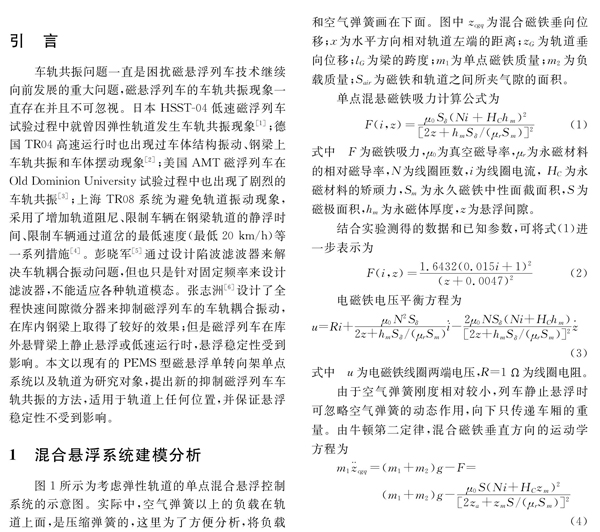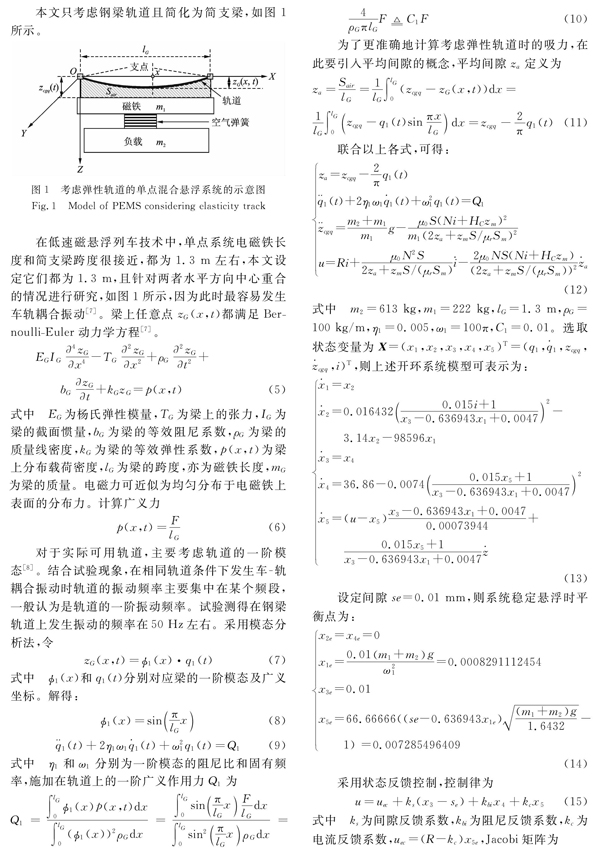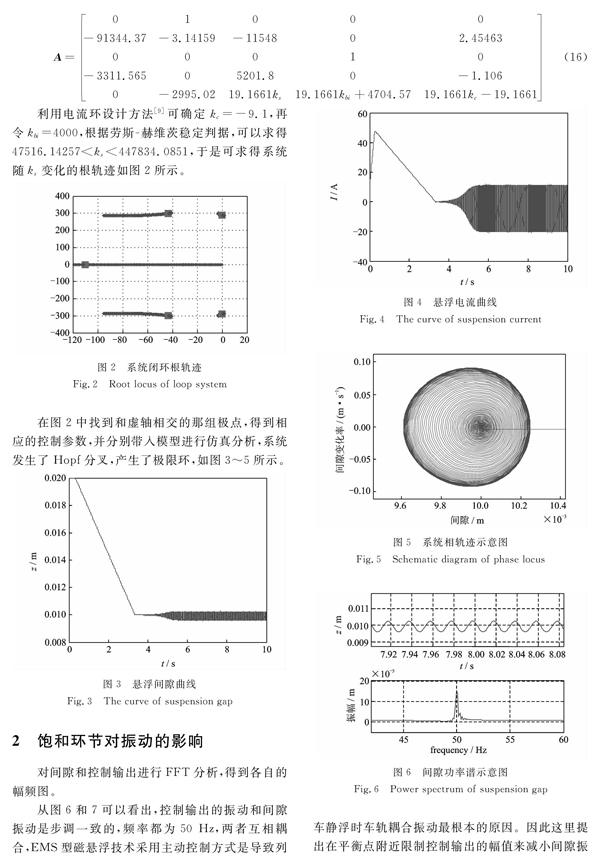永磁电磁型低速磁悬浮车轨耦合振动抑制新方法
李晓龙 龙鑫林 翟明达



摘要: 针对永磁电磁混合磁浮列车静浮实验中遇到的车轨耦合振动问题,首先建立考虑轨道弹性的系统数学模型,分析产生振动的原因,提出了通过设置非线性饱和环节、动态调整饱和阈值来抑制车轨耦合振动的新方法。系统在平衡点附近时通过调整饱和阈值来改变控制输出的幅值特性,逐步消除引起共振的能量,从而达到抑制振动的目的,系统在偏离平衡点时,快速释放饱和环节,进而提升控制器的调节能力和抗干扰能力。
关键词: 车轨耦合振动; 振动抑制; 永磁电磁混合型磁悬浮; 非线性饱和
中图分类号: U211.5; TB535文献标志码: A文章编号: 10044523(2016)04064907
DOI:10.16385/j.cnki.issn.10044523.2016.04.012
引言
车轨共振问题一直是困扰磁悬浮列车技术继续向前发展的重大问题,磁悬浮列车的车轨共振现象一直存在并且不可忽视。日本HSST04低速磁浮列车试验过程中就曾因弹性轨道发生车轨共振现象[1];德国TR04高速运行时也出现过车体结构振动、钢梁上车轨共振和车体摆动现象[2];美国AMT磁浮列车在Old Dominion University试验过程中也出现了剧烈的车轨共振[3];上海TR08系统为避免轨道振动现象,采用了增加轨道阻尼、限制车辆在钢梁轨道的静浮时间、限制车辆通过道岔的最低速度(最低20 km/h)等一系列措施[4]。彭晓军[5]通过设计陷波滤波器来解决车轨耦合振动问题,但也只是针对固定频率来设计滤波器,不能适应各种轨道模态。张志洲[6]设计了全程快速间隙微分器来抑制磁浮列车的车轨耦合振动,在库内钢梁上取得了较好的效果;但是磁浮列车在库外悬臂梁上静止悬浮或低速运行时,悬浮稳定性受到影响。本文以现有的PEMS型磁悬浮单转向架单点系统以及轨道为研究对象,提出新的抑制磁浮列车车轨共振的方法,适用于轨道上任何位置,并保证悬浮稳定性不受到影响。
1混合悬浮系统建模分析
图1所示为考虑弹性轨道的单点混合悬浮控制系统的示意图。实际中,空气弹簧以上的负载在轨道上面,是压缩弹簧的,这里为了方便分析,将负载和空气弹簧画在下面。图中zcgq为混合磁铁垂向位移;x为水平方向相对轨道左端的距离;zG为轨道垂向位移;lG为梁的跨度;m1为单点磁铁质量;m2为负载质量;Sair为磁铁和轨道之间所夹气隙的面积。
Abstract: Tracks coupling vibration in PEMS may occur in static suspension test. In this paper, the model of PEMS considering elastic track is established firstly, and the causes of tracks coupling vibration are analyzed in detail. A new method of suppressing tracks coupling vibration is put forward by setting up nonlinear saturation and adjusting the saturation threshold dynamically. The nonlinear saturation with adjustable threshold is applied to vary the output amplitude characteristic near the equilibrium point of the system, and the energy that causes resonance is gradually eliminated to achieve the purpose of restraining tracks coupling vibration. When the system deviates from the equilibrium point, the saturation is quickly released to avoid the impact for the regulating ability and antiinterference ability of the controller.
Key words: tracks coupling vibration; vibration suppression; PEMS low speed maglev train; nonlinearity saturation

